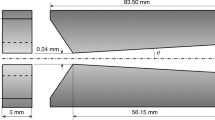Abstract
The supercritical carbon dioxide (Sc-Co2) drilling is a novel drilling technique developed in recent years. A detailed study of temperature and pressure distributions of the Sc-Co2 jet on the bottom of a well is essensial to the Sc-Co2 drilling. In this paper, the distributions of pressure and temperature on the bottom of the hole during the Sc-Co2 jet drilling are simulated experimentally and numerically, and the impacts of the nozzle diameter, the jet length, and the inlet pressure of the Sc-Co2 jet are analyzed. It is shown that, the bottom hole temperature and pressure increase with the increase of the nozzle diameter, and the bottom hole temperature reduces and the pressure increases first and then decreases with the increase of the jet length, indicating that the jet length has an optimum value. The increase of the inlet pressure can increase the temperature and pressure on the bottom, which has a positive effect on the drilling rate.
Similar content being viewed by others
References
HAUTHAL W. H. Advances with supercritical fluids [review][J]. Chemosphere, 2001, 43(1): 123–135.
STREET C. G., TESCHE C. and GUIGARD S. E. Treatment of hydrocarbon-based drilling waste using supercritical carbon dioxide[C]. SPE 106829, Galveston, Texas, USA, 2007, 1–7.
WANG Rui-he, HUO Hong-jun and DU Yu-kun et al. Analysis on the supercritical carbon dioxide drilling and completion techniques and their risks[C]. China Occupational Safety and Health Association 2010 Annual Conference. Shanghai, China, 2010, 297–301(in Chinese).
KOLLÉ J. J., MARVIN M. Jet-assisted coiled tubing drilling with supercritical carbon dioxide[C]. Proceedings of ETCE/Omae 2000 Joint Conference. New York, USA, 2000.
DU Yu-kun, WANG Rui-he and NI Hong-jian et al. Rock-breaking experimental study on the supercritical carbon dioxide swirl jet[J]. Journal of Basic Science and Engineering, 2013, 21(6): 1078–1083(in Chinese).
DU Yu-kun, WANG Rui-he and NI Hong-jian et al. Determination of rock-breaking performance of high-pre-ssure supercritical carbon dioxide jet[J]. Journal of Hydrodynamics, 2012, 24(4): 554–560.
WANG Rui-he, NI Hong-jian and DU Yu-kun et al. Supercritical fluid drilling experimental equipment[P]. China Patent, 201120017722. X, 2011(in Chinese).
YUE Wei-min. Development of rock-breaking experimental equipment under supercritical carbon dioxide jet[D]. Master Thesis, Dongying, China: China University of Petroleum (East China), 2011(in Chinese).
WANG Rui-hi. Research of rock fragmentation mechanism with high-pressure water jet[M]. Dongying, China: China University of Petroleum Press, 2010(in Chinese).
GOHIL T. B., SAHA A. K. and MURALIDHAR K. Direct numerical simulation of naturally evolving free circular jet[J]. Journal of Fluids Engineering, 2011, 133(11): 11203.
NI Hong-jian, WANG Rui-he and BAI Yu-hu. Numerical simulation study on rock breaking mechanism under high pressure water jet[J]. Journal of China University of Petroleum (Edition of Natural Science), 2002, 26(3): 37–40(in Chinese).
NI Hong-jian, WANG Rui-he. Numerical simulation study on pulse water jet crashing rock[J]. Petroleum Drilling Techniques, 2001, 29(5): 12–14(in Chinese).
HAN Zhan-zhong, WANG Jing and LAN Xiao-ping. Fluent simulation in fluid engineering[M]. Beijing, China: Beijing Institute of Technology Press, 2004(in Chinese).
RAO Zheng-hua, LIAO Sheng-ming. Numerical simulation of turbulent convective heat transfer of supercritical carbon dioxide in tube[J]. Fluid mechanics, 2005, 33(1): 71–72(in Chinese).
GUPTA A. P. Feasibility of supercritical carbon dioxide as a drilling fluid for deep underbalanced drilling operation[C]. SPE 96992. Dallas, Texas, Usa, 2005, 1–10.
WANG Zai-ming. Feature research of supercritical carbon dioxide drilling fluid[D]. Doctoral Thesis, Dongying, China: China University of Petroleum (East China), 2008(in Chinese).
Author information
Authors and Affiliations
Corresponding author
Additional information
Project supported by the Major State Basic Research Development Program of China (Grant No. 2014Cb239202, 2010Cb226700), the National Natural Science Foundation of China (Grant No. 51034007) and the Natural Science Foundation of Shandong Province (Grant No. ZR2011EEZ003).
Biography: WANG Rui-he (1957-), Male, Ph. D., Professor
Rights and permissions
About this article
Cite this article
Wang, Rh., Huo, Hj., Huang, Zy. et al. Experimental and numerical simulations of bottom hole temperature and pressure distributions of supercritical Co2 jet for well-drilling. J Hydrodyn 26, 226–233 (2014). https://doi.org/10.1016/S1001-6058(14)60025-1
Received:
Revised:
Issue Date:
DOI: https://doi.org/10.1016/S1001-6058(14)60025-1




